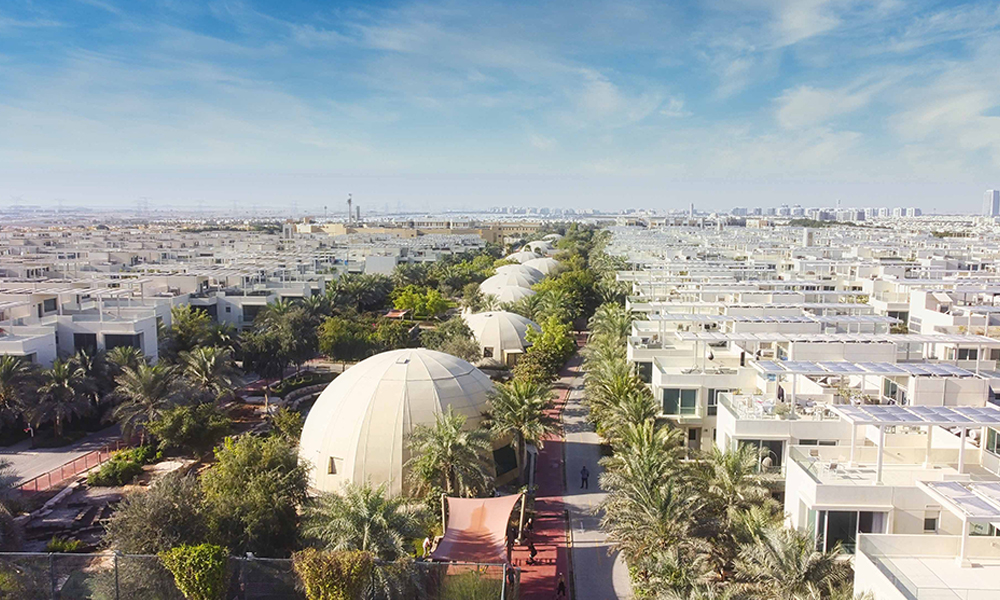I from Eedama, visited The Sustainable City to see what it looks like with my own eyes. Firstly, when I entered it looked usual to me, a community located in a desert in Dubailand, with many amenities such as residences, recreational facilities, educational institutions. Such as a school, university, and hospital, leisure facilities such as shops and restaurants, a mosque as every residential community would have. However, I was interested in finding what was “sustainable” in this community and what people in this community currently are doing about it. Hence, I took a walk into the community, and here’s what I found:
Sustainable Practices and Infrastructure at the Sustainable City
- Each resident has his/her electric car (buggy) provided by the city to drive around the community to amenities such as shops, restaurants, school, hospital, etc which are accessible by foot as well.
- It incorporates some green spaces as well such as landscaping gardens, animal sanctuary, greenhouse biodome farms, livestock farms, etc.
- People in the community mostly get their fruits and vegetables monthly from an urban farm i.e. the greenhouse biodomes that practice indoor/vertical farming and poultry and meat sources from livestock farms which is quite a sustainable approach.

solar PV panels
- Each resident in the Sustainable City has solar PV panels (should be 10MW) on the rooftops. The PV panels contribute to the overall energy mix of the city (and therefore Dubai) and have other roles: shading, and natural ventilation. The community uses several water-recycling technologies, including greywater recycling, rainwater harvesting, and wastewater treatment. They have a wastewater treatment plant that cleans the sewage and turns it into high-quality recycled water for irrigation and landscaping. They also collect rainwater in underground tanks to use for non-drinking purposes like flushing toilets and washing cars.
- Waste segregated bins are also present in each residential area which is a good approach to waste segregation technique. It is collected by “Tadweer”, Dubai’s leading material recovery facility, as of 2021 more than 80% of the waste around the city is sorted and recycled.
- There are composting bins too, which I need to know about since, as a visitor, I couldn’t enter the residential area or the greenhouse biodome farm.
- An E-waste recycling station was present to recycle old electronic items considered waste. This station is handled by “E-FATE”, a UAE-based e-waste management company, which installed a specialized container for recycling smart and toxic electronic waste. Residents can drop their e-waste at this station and then take it to a recycling facility for segregation.

Focus on Waste Management and Recycling
I feel the community has focused more on “waste” and how to recycle it, hence keeping more segregated waste bins, an e-waste recycling station, and composting bins for residences to practice waste segregation and recycling and composting techniques.
Greenhouse Biodome Farm and Urban Farming Practices
The greenhouse biodome farm is quite impressive (from what I had seen) only in terms of how food sources are being supplied throughout the community from these farms, and they follow “sort of sustainable” agriculture practices. Urban farming is important in any sustainable community. It helps to develop environmental and social goals and it is important to maintain natural systems.
Concerns Over Electric Vehicle Usage and Sustainable Practices
Sadly, I can see that in terms of usage of buggies (electric mini-cars), the residents living there are finding it convenient to take them even for walkable distances which they think is a sustainable approach without realizing the amount of energy (electricity, and car production) they are consuming by taking these vehicles to their advantage. This says The Sustainable City is a community that built eco-friendly operations and maintenance but did not take into completion. I feel citizens living in this city are doing what’s convenient rather than working towards following sustainable practices which will make this city more “sustainable”.
Suggestions for Improvement and Future Outlook
I would also suggest The Sustainable City becomes more of a community for visitors such as students or stakeholders pursuing this industry to seek information and not just a residential area which will encourage more citizens in Dubai to visit various areas in this community and know what’s it’s all about. Finally, I feel that the Sustainable City in Dubai still has a long way to go, and if solely people’s behavior and actions are changing and thinking about what’s right over what’s convenient, this city can then be considered “a sustainable community”.
Sign: Nidhi, from Eedama – May 2024
PS: My colleagues from Eedama visited The Sustainable City back in 2016. Eedama was the 1st education provider in the City, hosting hundreds of students from 2016 to 2018. It’s interesting to see that, despite a lot of progress from 2016 to 2024, several of the remarks I gave here were already valid in 2024.
